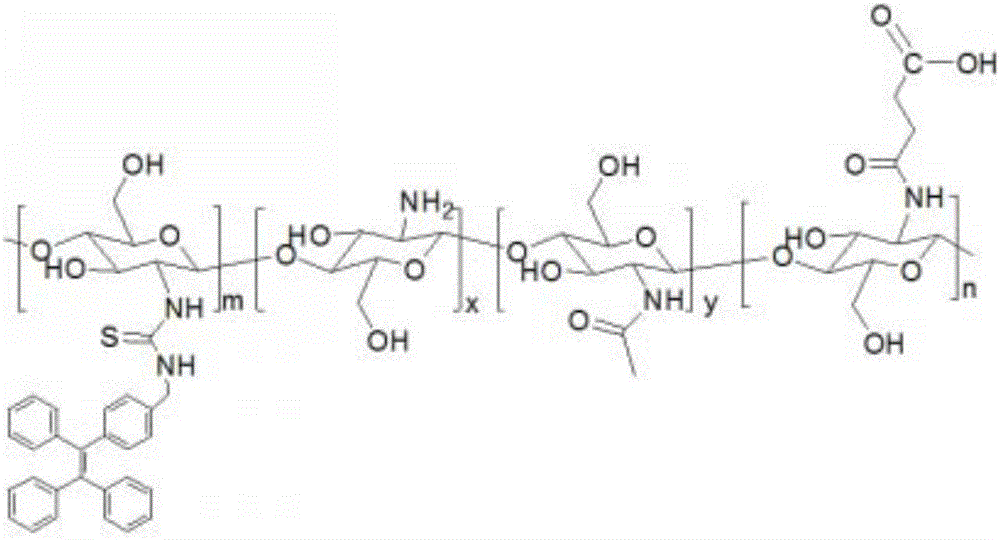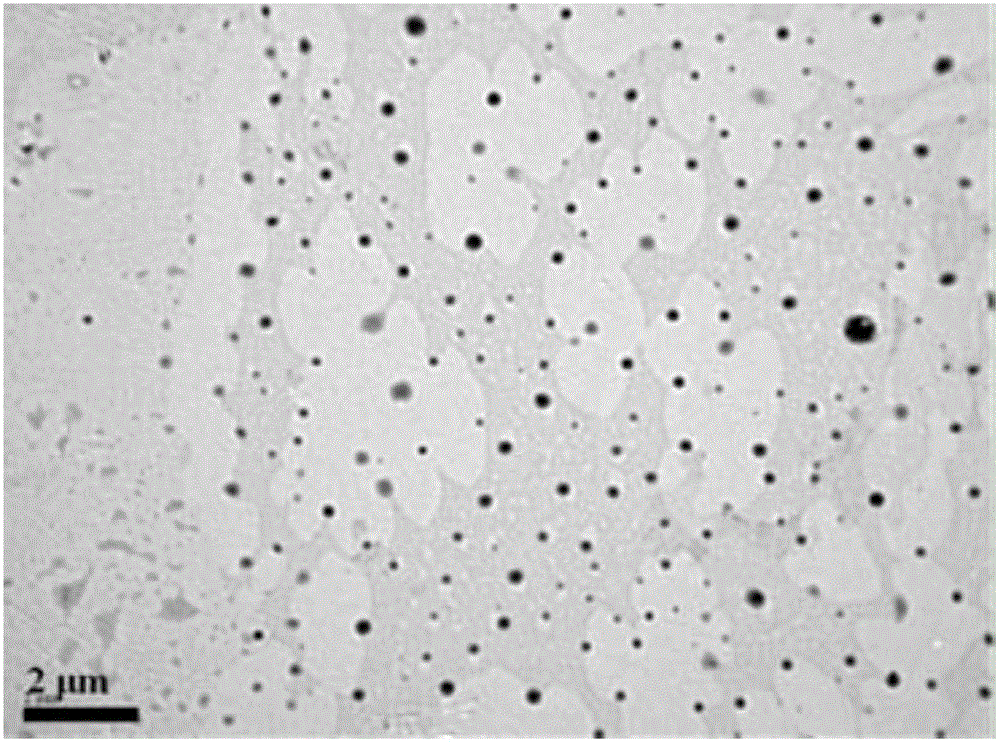Carboxylation chitosan nano-fluorescence probe with aggregation-induced emission characteristic and preparation method thereof
A nano-fluorescent probe, aggregation-induced luminescence technology, applied in chemical instruments and methods, luminescent materials, fluorescence/phosphorescence, etc., can solve the problems of fluorescent probe light instability, achieve uniform size, wide pH soluble, sensitivity high effect
- Summary
- Abstract
- Description
- Claims
- Application Information
AI Technical Summary
Problems solved by technology
Method used
Image
Examples
Embodiment 1
[0017] 1) Weigh 1g of carboxylated chitosan (viscosity-average molecular weight is 10,000, degree of acetylation is 20%, degree of carboxylation 20%) is added into an eggplant-shaped bottle, dispersed in 10mL DMSO, swelled at 50°C for 12h, and then added to Add TPEITC in the eggplant-shaped bottle, the molar ratio of TPEITC and the amino group in chitosan is 1%, react for 24h, obtain solution A and pour it into a 250mL beaker;
[0018] 2) Add 100mL tetrahydrofuran to solution A, stir evenly, let it stand until the solution is separated, remove the supernatant, centrifuge, dissolve the obtained precipitate with 20mL absolute ethanol and ultrasonically disperse for 20min, centrifuge, and dissolve the precipitate with 5mL triple distilled water Dissolve to obtain solution B;
[0019] 3) Put solution B into a dialysis bag with a molecular weight cut-off of 3500 and dialyze in three-distilled water for 4 days, freeze-dry to obtain fluorescently labeled carboxylated chitosan TPE-NCS...
Embodiment 2
[0023] 1) Weigh 1g of carboxylated chitosan (viscosity-average molecular weight is 50,000, degree of acetylation is 15%, degree of carboxylation 30%) is added into an eggplant-shaped bottle, dispersed in 10mL DMSO, swelled at 50°C for 12h, and then added to Add TPEITC to the eggplant-shaped bottle, the molar ratio of TPEITC and amino groups in chitosan is 5%, react for 24h, obtain solution A and pour it into a 250mL beaker;
[0024] 2) Add 100mL tetrahydrofuran to solution A, stir evenly, let it stand until the solution is separated, remove the supernatant, centrifuge, dissolve the obtained precipitate with 20mL absolute ethanol and ultrasonically disperse for 20min, centrifuge, and dissolve the precipitate with 5mL triple distilled water Dissolve to obtain solution B;
[0025] 3) Put solution B into a dialysis bag with a molecular weight cut-off of 3500 and dialyze in three-distilled water for 4 days, freeze-dry to obtain fluorescently labeled carboxylated chitosan TPE-NCS; ...
Embodiment 3
[0030] 1) Weigh 1g of carboxylated chitosan (viscosity-average molecular weight is 200,000, degree of acetylation is 10%, degree of carboxylation is 35%), add it into an eggplant-shaped bottle, disperse in 10mL DMSO, swell at 50°C for 24h, and then add to Add TPEITC to the eggplant-shaped bottle, the molar ratio of TPEITC and amino groups in chitosan is 10%, react for 36h, obtain solution A and pour it into a 250mL beaker;
[0031] 2) Add 100mL tetrahydrofuran to solution A, stir evenly, let it stand until the solution is separated, remove the supernatant, centrifuge, dissolve the obtained precipitate with 20mL absolute ethanol and ultrasonically disperse for 20min, centrifuge, and dissolve the precipitate with 5mL triple distilled water Dissolve to obtain solution B;
[0032] 3) Put solution B into a dialysis bag with a molecular weight cut-off of 3500 and dialyze in three-distilled water for 4 days, freeze-dry to obtain fluorescently labeled carboxylated chitosan TPE-NCS;
...
PUM
 Login to View More
Login to View More Abstract
Description
Claims
Application Information
 Login to View More
Login to View More - R&D
- Intellectual Property
- Life Sciences
- Materials
- Tech Scout
- Unparalleled Data Quality
- Higher Quality Content
- 60% Fewer Hallucinations
Browse by: Latest US Patents, China's latest patents, Technical Efficacy Thesaurus, Application Domain, Technology Topic, Popular Technical Reports.
© 2025 PatSnap. All rights reserved.Legal|Privacy policy|Modern Slavery Act Transparency Statement|Sitemap|About US| Contact US: help@patsnap.com



